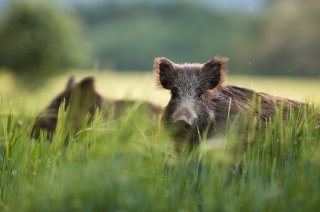
Showcase
WUR expands toolbox to quickly identify viruses
Virologists and health authorities had warned for years about a pandemic due to an as-yet-unknown pathogen – ‘disease X’ – that could paralyse the world. Then came COVID-19. Researchers from Wageningen University & Research are working on methods to detect zoonoses quickly in various types of samples. Because the question is not if another virus will rear its head, but when.
The Netherlands is a densely populated country and we live in close proximity with livestock. This makes our country a potential hotspot for zoonoses: infectious diseases that can be passed from animals to humans. One example is Hepatitis E. Pigs can carry that virus without being affected by it. People usually become infected by eating undercooked pork and can become seriously ill.
”Almost 70 percent of all new emerging viruses that make people sick originate in animals. To cause a pandemic, however, a pathogen must circulate easily between people. These are generally viruses that are transmitted through the respiratory tract. Influenza, which can infect humans, birds or pigs, is an example of such a respiratory virus. Coronavirus is another,” says professor of virology Wim van der Poel. “It is almost certain that new viruses will emerge in the future. But estimating where and when that will happen and whether it will lead to a pandemic is difficult.”
Quickly identifying new and dangerous ‘x’ viruses is a huge challenge, but a true revolution has taken place in the laboratory.
Revolution in the laboratory
According to Van der Poel, it is therefore important to detect viruses in animals and in the environment as quickly as possible so livestock farmers and animal health authorities can quickly take measures to contain the pathogen. “Quickly identifying new and dangerous ‘x’ viruses is a huge challenge. But a true revolution has taken place in the laboratory. New molecular techniques such as whole genome sequencing have enabled very rapid determination of the entire genetic code of a virus, i.e. the sequence of the DNA or RNA. We look at the sequence of nucleic acids, which is different for every virus. We will soon be able to compare these sequences with a database in which all known viruses are described.”

The researchers also ensure that the sequence data is stored in the best way. Van der Poel: “In the event of an outbreak, we can use smart computer software to quickly compare sequences, also sequences determined by others. This enables us to identify the virus and the variant. Sometimes the RNA sequence does not match any of the sequences in the database. In that case we may be dealing with a mutation of a virus or a new virus.”
Samples from wastewater
To extract the sequences from viruses, the researchers collect many different kinds of samples. For example, they receive animal samples (throat/nose swabs) via the Dutch Wildlife Health Centre and they receive swabs from colleagues within the ERRAZE@WUR research programme. “We also take samples from the living environment, for example from surface water and wastewater. Then we need to concentrate or amplify the viruses. This is necessary because samples often contain amounts of DNA or RNA that are too small to work with immediately. We have several ways to do this. For example, we can do this directly via the PCR technique (Polymerase Chain Reaction). Or it could make more sense to first concentrate a sample from wastewater by filtering the water,” explains van der Poel.
We have expanded our toolbox with instruments that we can use to determine whether pathogens are dangerous and can spread rapidly.
Once the sequences have been included in the database, the researchers look at what different variants of viruses do biologically: what is the relationship between the RNA code and the biological activity, how does the virus (or variant) behave? Does it make animals sick and can they infect humans? “We would like to be able to predict this better. For example, if you see a certain mutation, you can estimate the risks more accurately: is another animal species also vulnerable, or will the virus be able to replicate more quickly? Ultimately, we will expand our toolbox with instruments that enable us to demonstrate whether pathogens are dangerous and can spread quickly.”